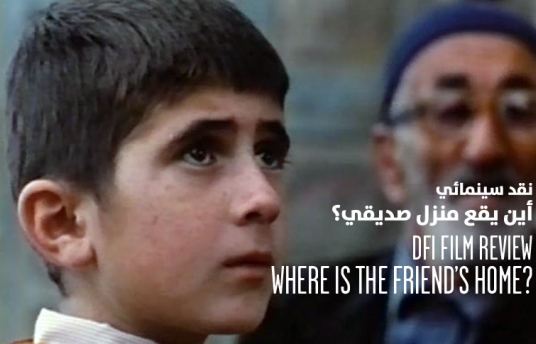DFI Film Review: Where is the Friend's Home? (1987)
Sep 11, 2011

Written by Reem Saleh, New Media, DFI
Film: Khane-ye doust kodjast? (Where is the Friend’s Home?)
Year: 1987
Director: Abbas Kiarostami
Stars: Babek Ahmed Poor, Ahmed Ahmed Poor and Kheda Barech Defai
Genre: Drama
This film is the reason why I became hooked on Iranian cinema, and turned into one of director Abbas Kirostami’s faithful admirers. It opened my eyes to an exclusive style in visual storytelling based on a simple plot but filled with substantial and poignant details.
At first I was confused by which of Kirostami’s films to write about and decided that ‘Khane-ye Doust Kodjast?’ (Where is the Friend’s Home?) would be a good start, mainly because it introduced Kiarostami to the international stage and established him as a visionary Director.
The film takes place in rural Iran, in a village called Koker. It is about eight-year-old Ahmed (Babek Ahmed Poor), who has mistakenly taken Mohamed Reda’s (Ahmed Ahmed Poor) notebook. He wants to return it, or else his friend will be severely punished by the teacher. The conscientious boy then decides to look for Mohamed’s home.
As soon as Ahmed returns home from school, he is never really able to finish his homework. He is continuously interrupted to work on different tasks (helping his mother, grandmother, supporting his baby brother…). He then realizes he has taken his friend’s notebook by mistake, and tries to convince his mother of how serious the punishment would be if he doesn’t return it. Not aware of the gravity of this situation, the mother refuses. Not knowing how to solve this problem, Ahmed grabs the opportunity of buying bread to look for his friend’s home. Ahmed’s benevolent quest begins, and his only guides are the name of the neighboring village and the name of his classmate, Reda.
The search makes of Ahmed a little hero who risks severe punishment from his father for helping his classmate, not going to buy bread. With him, we move from door to door, asking people for directions. With every door, we share a glimpse of a story, a hint of the way these people survive through the day. We also meet other children, all engaged in family tasks, carrying milk barrels heavier than themselves, with determination and a serious sense of responsibility. How can one be indifferent to that?
In this slow paced film, the mood is introduced with long shots and uncut scenes. We are given the time to look from a distance at the action, and to understand a culture while witnessing the daily routines of families and children in rural Iran. Kiarostami is also known for working with non- professional actors (except for his latest ‘Certified Copy’ with French superstar Juliette Binoche) but manages to stimulate genuine performances for a documentary-like feel. In this sense, it’s reality at the service of fiction.
In spite of this, I am still bedazzled at the magnificent acting of the kids,. Their striking innocence and strong eyes make them powerful characters, growing up and inheriting responsibilities a bit too soon. This is not the first time Kiarostami worked with children, it is in his habit to portray their candid point of view as a metaphor of the harsh world they’re living in. It’s a secured set up to penetrate emotions strongly and effectively.
Besides his documentary-like methods, rural landscapes allowed Kirostami to create a unique signature of his works. One can’t but notice his frequent zigzag-like roads, and this became his trademark. It creates a visual poetry, a serene and reflexive link that protagonists use back and forth. To actually have a personal film identity means that his techniques resemble no one. French master Jean-Luc Godard said in this regard: “Film begins with DW Griffith and ends with Abbas Kiarostami.” And According to Martin Scorsese, “Kiarostami represents the highest level of artistry in the cinema.” Source: The Guardian.
This is how Kiarostami, through minimal elements, teach us to see the world through children. And gives us a lesson or two on incidents that marks us inevitably.
Following the shooting of this film, an earthquake hit the village of Koker in 1990, and the director and his son went looking for the protagonists in Koker where half of it was shot. This became a semi-fictional work titled ‘Life and nothing more…’ It is the second of the Koker trilogy (referring to all three films featuring this village), followed by ‘Taste of Cherry’. ‘Life and nothing more…’ is a real-life lesson on moving on following tragic events. It is an engaging journey by a minimalistic director who masters the tale of big yet simple stories, proving that “ a picture says a thousands words”.
Khane-ye Doust Kodjast - (Where Is the Friend's Home) - Trailer
إعلان فيلم أين يقع منزل صديقي؟